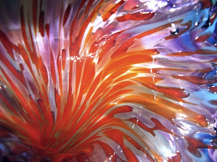Halotechnics -- Molten Glass Thermal Storage Could Mean 6 Cent Solar
 Halotechnics, an early-stage solar-thermal startup and ARPA-E recipient, has developed two radical new materials for storing solar heat energy, using new kinds of salts and even a new kind of glass.
Halotechnics, an early-stage solar-thermal startup and ARPA-E recipient, has developed two radical new materials for storing solar heat energy, using new kinds of salts and even a new kind of glass.These allow much higher temperatures than have been used to date to store the heat in solar thermal power plants so they can produce power at night. This will greatly improve the efficiency and lower the costs for solar thermal power.
This is a first. While practically every other day we hear about efficiency innovations that will lower the costs of PV solar, this is a major innovation for solar thermal.
Unlike solar PV which makes electricity directly, solar thermal makes heat that runs turbines driven by steam. So, unlike solar PV, it has the potential for night time solar generation, because thermal is steam-turbine-driven energy, so it can store the days heat in molten salt solutions for tapping later as needed. This evening peak hours flexibility is its advantage over (now) cheaper PV.
Improving energy storage would reduce the cost per kilowatt-hour of the electricity produced by a solar-thermal plant, because the turbines and generators can produce power for more hours, more cheaply, if the temperatures can be kept high enough. Being able to store energy at higher temperatures is the key to cutting the costs of solar thermal, and that is what Halotechnics has pioneered.
“To hit that six-cent goal, or get close to it, you have to go to a higher-temperature system,” says Mark Mehos, manager of the National Renewable Energy Laboratory’s Concentrated Solar Power program, in Golden, Colorado. “The systems that are commercial today are limited to about 565 °C—that’s the molten salt tower plants,” says Mehos. “The tower and optics themselves can hit higher temperatures, but you’re limited by the salt temperature right now.”
Halotechnics was a spin-out from a chemical screening company Symyx (now a part of Accelrys). And that is key to its success, because to find the perfect material to allow the heat to be raised in solar energy storage, Halotechnics was able to comb through nearly 18,000 mixtures using this type of high-throughput chemical screening process. It was an ARPA-E grant recipient ($3.3 million) last year as a result.
“Without an amazing ability to screen samples, it’s an intractable problem. That’s what we’re trying to do with our high-throughput technique,” says Justin Raade, CEO of Halotechnics.
The materials they have devised, which include new mixtures of salts as well as new forms of molten glass materials, could be key to making solar-thermal power plants cheap and reliable enough to compete with fossil fuels on a large scale.
The U.S. Department of Energy’s SunShot Initiative has the goal of reducing solar costs to six cents per kilowatt-hour. Last year it gave the start-up a $1 million NREL subcontract with the goal of developing thermal energy storage that could operate at 700°C.
Halotechnics not only met but surpassed that 700°C goal: one of their new molten glass materials can work at temperatures up to 1,200 °C, says NREL’s Mehos.
According to MIT:
“This is a form of glass that melts at 400 °C (typical window glass melts at about 600 °C) and can operate up to 1,200 °C. It could be used to heat up air to drive a gas turbine, with the leftover heat used to drive a steam turbine, much as is done in a natural-gas combined-cycle plant. Such a system could be about 52 percent efficient using existing turbine designs. (Natural-gas combined-cycle plants can reach 60 percent efficiency, but the natural gas burns at temperatures higher than 1,200 °C.)”
Operating at such high temperatures, however, will bring engineering challenges, including finding relatively inexpensive materials to contain the extremely hot molten glass. Commercialization of this technology could be many years away.
You can return to the main Market News page, or press the Back button on your browser.

